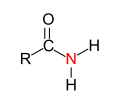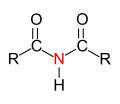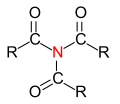
Quartär (Chemie)
| Rot markierte
Zentralatome in verschiedenen Stoffgruppen. Vergleich von quartären mit primären,
sekundären
und tertiären
Zentralatomen. | ||||
| primär | sekundär | tertiär | quartär | |
| Kohlenstoffatom einer organischen Verbindung |
 |
 |
 |
 |
| Alkohol |  |
 |
 |
existiert nicht |
| Amin |  |
 |
 |
 (siehe QAV) |
| Carbonsäureamid |  |
 |
 |
existiert nicht |
| Phosphin |  |
 |
 |
 (siehe QPV) |
In der organischen Chemie ist das Wort „quartär“ eine Bezeichnung für vier an ein Zentralatom (Kohlenstoff, Stickstoff, Phosphor) gebundene organische Reste (Organyl-Rest, wie Alkyl-Rest, Alkenyl-Rest, Aryl-Rest, Alkylaryl-Rest etc.).
Beispiele für quartäre Zentralatome
- ein Kohlenstoffatom in einem Alkan, an das vier Substituenten jedoch kein Wasserstoffatom gebunden ist,
- ein Stickstoffatom in einem quartären Ammoniumsalz, an das vier Kohlenstoffatome gebunden sind oder
- ein Phosphoratom in einem quartären Phosphoniumsalz, an das vier Kohlenstoffatome gebunden sind.
Beispiele für solche Verbindungen ist das Alkan Neopentan (2,2-Dimethylpropan) mit dem quartären Kohlenstoffatom in der Mitte, das quartäre Ammoniumsalz Tetrabutylammoniumbromid und das quartäre Phosphoniumsalz Tetramethylphosphoniumbromid.
Siehe auch


© biancahoegel.de
Datum der letzten Änderung: Jena, den: 10.09. 2021